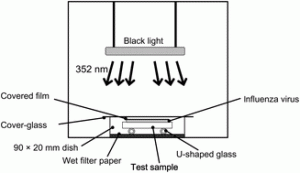 The photocatalytic inactivation of influenza virus using titanium dioxide thin film is demonstrated in a recently published paper from Ryuichi Nakano and co-workers from Japan. Titanium dioxide (TiO2) under ultraviolet (UV) light produces a strong oxidative effect and may therefore be used as a photocatalytic disinfectant. Photocatalytic inactivation of bacteria is well known, however few studies have addressed virus inactivation.
The photocatalytic inactivation of influenza virus using titanium dioxide thin film is demonstrated in a recently published paper from Ryuichi Nakano and co-workers from Japan. Titanium dioxide (TiO2) under ultraviolet (UV) light produces a strong oxidative effect and may therefore be used as a photocatalytic disinfectant. Photocatalytic inactivation of bacteria is well known, however few studies have addressed virus inactivation.
In this paper the inactivation of influenza virus is demonstrated using TiO2 nanoparticles immobilized on a glass plate. Viral titers were dramatically reduced by the photocatalytic reaction and the influence of UV intensity, irradiation time and bovine serum albumin concentration in viral suspensions was investigated. It was demonstrated that effective inactivation occurs under an environmental level of UV-A intensity. In addition, the International Organization for Standardization (ISO) methodology for anti-bacterial effects of TiO2 photocatalysis can be useful for the evaluation of antiviral activity with only a small modification to the methodology.
Interested in knowing more? Read the full article for free until June 14th by clicking the link below!
Photocatalytic inactivation of influenza virus by titanium dioxide thin film
Ryuichi Nakano, Hitoshi Ishiguro, Yanyan Yao, Jitsuo Kajioka, Akira Fujishima, Kayano Sunada, Masafumi Minoshima, Kazuhito Hashimoto and Yoshinobu Kubota
Photochem. Photobiol. Sci., 2012, DOI: 10.1039/C2PP05414K
You can keep up to date with the latest developments from PPS by signing up for free table of contents alerts.










